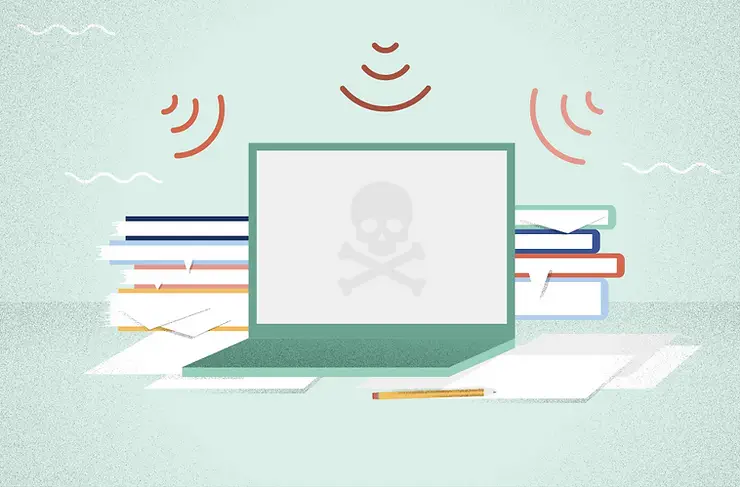Toxic is a fuzzy term without a clear definition. It’s commonly used to describe something unhealthy: toxic chemicals, ingredients, relationships. When used to describe a relationship—with a partner, a friend, or a workplace—it usually implies psychological harm, sometimes even with physical manifestations. (Stress hurts the body too!)
But what exactly is a toxic workplace? It’s a term we hear a lot (quiet quitting anyone?) but not very well defined.
Because of that, we can’t tell you if your workplace is toxic. That’s a tough call, and one you likely have to make yourself. But we can share a few helpful definitions, the signs that you might be in one, and—most importantly—what to do about it.
What is a toxic work environment?
There’s no singular definition of “toxic workplace.” The Wharton School at the University of Pennsylvania qualifies a toxic workplace as one in which employees feel demeaned, berated, bullied, or held to an unfair standard—and that can take many forms.
In his TED podcast, Adam Grant defines toxicity as a prioritization of “results without relationships.” That means: “Getting things done at the cost of treating people right. The organization tolerates disrespect, abuse, exclusion, unethical decisions, and selfish cutthroat actions.” In fact, it might promote people who engage in these behaviors.
Analysis published by MIT found that the leading elements contributing to toxic work cultures, also known as the “Toxic Five,” include:
- Disrespect (lack of consideration, courtesy, and dignity)
- Non-inclusivity (racial inequality, gender inequality, etc.)
- Unethical business practices
- Ruthless competition
- Workplace hostility
Signs of a toxic workplace
What might this look like in practice? The following behaviors and work conditions could be signs of a toxic work environment:
- Pervasive office gossip. Talking about what’s happening at work with the people you work with is only natural. However, when those conversations turn negative and non-productive, they can cross the threshold and become petty gossip. It is never a good sign when gossip, rather than constructive feedback, becomes the norm in an organization.
- High levels of workplace stress. Every job carries with it its own set of responsibilities and the occasional tight deadline. But that feeling that everyone is constantly running on fumes because everything is constantly “on fire,” is usually unhealthy.
- No care for mental health and physical health. Covid and work from home really changed how we talk about mental and physical health at work. There’s now much more alignment among company leaders that considering and supporting employees’ mental and physical health is important. A workplace that doesn’t allow employees to take care of their whole selves might be toxic.
- Unsustainable work hours. Constant demands to work outside of business hours erodes work-life balance and ultimately leads to toxicity.
- Lack of respect for personal and professional boundaries. Just as with romantic partners, friends, and family, setting boundaries with work is important. If those boundaries are consistently violated, the workplace may be unhealthy.
- A lack of investment in DEI (diversity, equity, and inclusion) efforts. Research proves that the best work is done when people who don’t think alike, look alike, or share overly similar lived experiences come together. A homogeneous workplace, or one that isn’t attempting to invest in and support a diverse team, may be toxic.
- Failure to recognize good performance. Good work always deserves recognition. A healthy team is one that celebrates stellar work, as well as the people who went above and beyond to do it.
Remember: This list is not exhaustive, and what constitutes a toxic work environment might look different from company to company.
Toxic work environments are lose-lose
Toxic work environments are deeply unpleasant for everyone involved, and they can have negative impacts on the organization as a whole. These company-level impacts might be further signs of a toxic work environment.
- Everyone is leaving. Toxic workplace culture is the number one reason employees leave companies. In fact, it’s ten times more likely than the next factor, compensation, to send employees in search of a new professional home. If you look around and notice that many of the folks who used to work with you no longer do, it might be a sign of a toxic workplace.
- Productivity is low. Research shows that when employees feel stigmatized and burnt out, they are likely to be less productive. If you feel like your productivity is plummeting and/or that your team is falling behind, you might be in a toxic workplace.
- Creativity is hard to come by. It might not have anything to do with you if you find yourself uninspired at work. Toxic workplaces—with their unrealistic expectations or rigid hierarchies—are creativity killers and might be the reason you’re experiencing writer's block (or whatever kind of “block” you might find yourself up against!).
Toxic vs. hostile work environments: what are the differences?
Occasionally, unhealthy workplace environments can take the leap from being toxic to being hostile—and that’s a different situation. The term “toxic” has many meanings, whereas “hostile” has a specific legal meaning.
For a workplace to be considered hostile, it must be severe or pervasive. The behavior must be targeted at a protected characteristic, and the harassment must affect your or someone else’s ability to work.
If you think this describes your workplace, the most important thing we can say is to bring this concern to your leadership, whether that’s a manager, HR, legal, or compliance. It’s really important that you speak up. In fact, developing a strong speak up culture is one of the best ways to both address and even prevent the effects of a toxic workplace.
How to handle a toxic work environment
If you find yourself working in a toxic environment, you’ll need a set of strategies to navigate through and potentially out of it. Consider the following tips as a place to start.
- Be specific about what you’re observing. If you’re seeing concerning behavior, be as specific as possible when you share those concerns with leadership. Similar to reporting for a high school newspaper, think about 4 of the 5Ws: who, what, when, and where. Stay away from the “why” since you’d be making assumptions. Be as objective as you can.
- Speak up. Address your concerns with your manager or with human resources (AKA People Operations), Legal, or Compliance teams. After all, that’s what they're there for. We know speaking up might be difficult, especially if it’s not already part of the culture at your workplace. Doing so can help create a “speak-up culture” from the ground up.
- Role model great peer feedback. Peer feedback is an incredibly powerful tool when it comes to creating a healthy workplace. However, there are many reasons why people might feel reluctant to share feedback with their peers, such as: “It’s not my job” or “It’s awkward.” Try employing a framework for giving feedback so that you can become a role model giving live, direct feedback when you see examples of toxic or unhealthy behavior.
- Advocate for change. Bring up ways to improve the situation with your manager or People team. Some suggestions you can bring to them to help build a better workplace are:
- Training. Great training can help improve all aspects of company culture, from preventing harassment to improving diversity, equity, and inclusion, to defining an interviewing and hiring process.
- Surveys. Surveys can surface issues and provide leadership with data in a way that face-to-face conversions might not be able to. Does your company do a mid-year engagement survey? Exit surveys with employees who are leaving? If not, suggest your company start collecting data so they can see where issues are without having to put employees on the spot in meetings or check-ins.
When to walk away from a toxic workplace
Just as it’s important to speak up and try and make a change when you can, it’s also important to know when it’s time to walk away.
If you’re thinking about leaving, consider these things first:
- Have I explored all my options for addressing the issue (if you feel safe)?
- Did you take it up with your manager or the People Team?
- Are you experiencing ongoing toxic conditions and behavior?
If you’ve weighed these considerations and still feel like it’s time to move on, well, there’s your answer! Remember, a rough patch at work doesn’t necessarily mean you’re in a toxic work environment, but if you are in one and it can’t be remedied, you can be your own solution.











